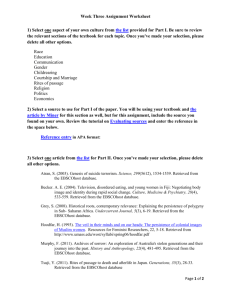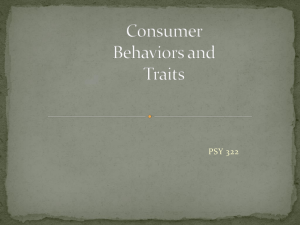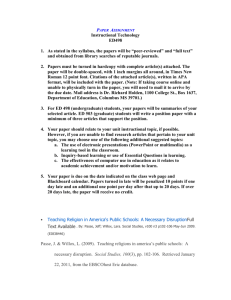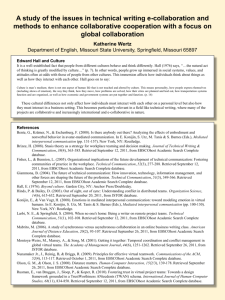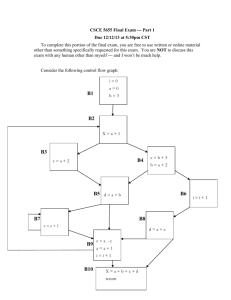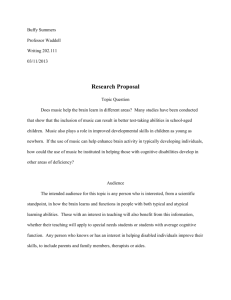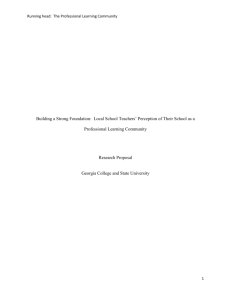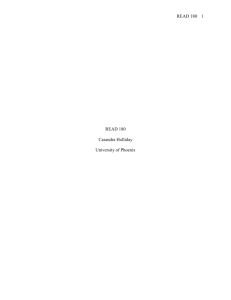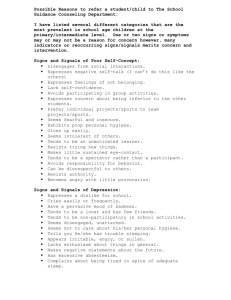Virtual Teams Part I Student Roles and Assignments
advertisement
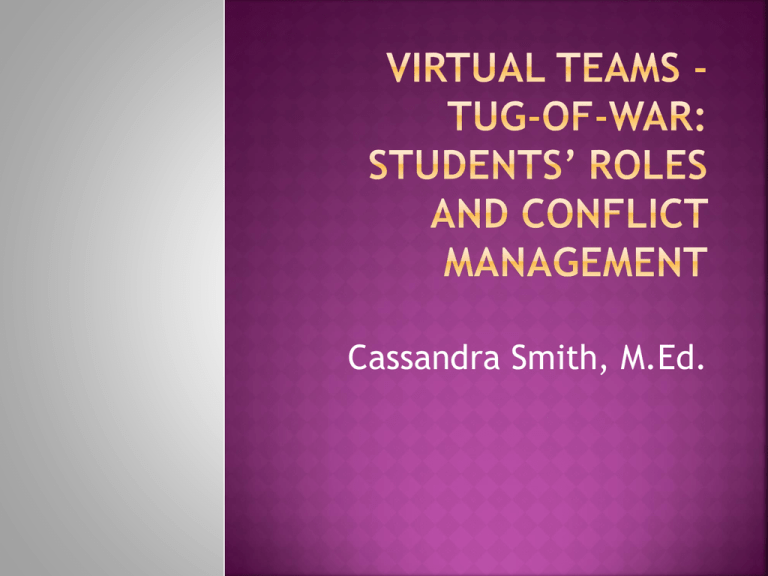
Cassandra Smith, M.Ed. Understand different student roles that might emerge in virtual teams. Understand the importance of taking an active role as the instructor in virtual teams. Identify roles and characteristics that influence team dynamics. Identify conflict strategies that can help resolve issues in virtual teams. O’Leary and Cummings (2007 as cited in Dube & Robey, 2008) defined virtual teams as an interdependent group of people working towards a common goal while separated by geographic distance, time and/or location. You are a manager for the IT department. Two employees on a team come to you at different times explaining that one employee isn’t contributing to the team work and the other feels as if when he contributes his ideas are not well received. How would you intervene? I don’t like virtual teams… I returned to school online to work independently not to be forced to work in a virtual team… I do not like my grade contingent upon others… I do not think it is fair that some students have to submit most of the work when other members slack… I do not feel a strong instructor presence when conflicts arise… Leadership Assess skills (patience, organization) Goal setting (accountable/deadlines) Project management (guide/set timelines) Collaborative learning (relinquish personal agendas) Critical thinking (logical thought processes) Side note: Qualitative and Quantitative data The Aggressive Role The Passive Role The Slacker Role The I’ll Do It Role Aggressive role – person who exhibits this role wants to do the majority of the assignment (control the assignment) or tells everyone else what to do on the team. He or she is more of a dominator on the team than innovator especially if no one has responded. Maybe you should do it! You are only compiling the assignment. Example Assignment: Instructional Plan Team A consists of Tina, Jerry, San, and Bob Tina sends an email to the team forum and says she thinks the team should do an Instructional Plan on “How to give a Creative Presentation” The team agrees. Tina completes the assignment. Everything is complete except the conclusion, and she sends a message to the team saying someone else on the team can add the finishing touches. Passive role – a person who exhibits this role on the team waits for everyone else to respond before selecting an assignment section. He or she will not volunteer. Slacker Role – a person who exhibits this role on the team does little to help the team. He has no time for team assignments… I’ll Do It Role – a person who exhibits this role on the team fulfills several responsibilities on the team and volunteers and will do any part of the assignment when no one else on the team wants to work or volunteers. He carries the brunt of the team projects. Conflict is defined as “An expressed struggle between at least two interdependent parties who perceive incompatible goals, scarce rewards and interference from the other party in achieving their goals” Hocker and Wilmont (1992). Conflict management involves executing resolution and includes the principle that all conflicts cannot necessarily be resolved, but learning how to manage conflicts can decrease the odds of nonproductive escalation (Bakhare, 2010). Miscommunication Student inconsistency Student work ethics Lack of reading Unclear assignment instruction Not enough sections to write for assignments Dyad: Have students work in class in the team assigned section Preparation Conflict (slow start, unclear instructions, duplicated sections, leader confusion (Volunteering someone) Leadership Conflict (dominator versus innovator, same person lead - other team members not volunteering, changing assignment) Withdrawal Conflict (male versus female scenarios, or students not fully participated because of conflict, plagiarizing part of the work) Instructor Must take an Active Role Monitor (often, 3x a day) Weekly Check-in (email or message thread worth points) Intervene (send message) Team Document (guidelines, assignment sections) Assign a team leader (to compile the assignment) Team Agreement (ground rules, meetings) Grade (specific individual team feedback) Syllabus Alert Accountability Model the behavior Intervene Reinforce Post messages Syllabus alert Team document Well, maybe not that angry! This is much better! Extraversion Agreeableness Conscientiousness Neuroticism Openness John & Srivastava, 1999 as cited in Jacques, Garger, Brown, & Deale. Individual is talkative, full of energy, and emotionally expressive Individual is helpful and unselfish with others, Individual does a thorough job, is reliable Individual is tense worries more than others Individual is original curious about many things, and inventive Cassandra Smith, M.Ed. Cassiesmith41@gmail.com Follow me on Twitter: CjdistanceEdu and FirstNovel Author of books: Who Let this Disaster in My Classroom Ethical Behavior in the E-Classroom Both Available on Amazon.com Bakhare, R. (2010). The Manager and Conflict Management. SCMS Journal of Indian Management. Retrieved from EBSCOhost. Dube, L., & Robey, D. (2008). Surviving the paradoxes of virtual teamwork. Information Systems, 19. Retrieved from EBSCOhost. Hocker, J.L., & Wilmot, W.W. (1991). Interpersonal conflict. Dubuque, IA: Wm. C. Brown. Retrieved from Conflict Management for Teams. http://www.uni.edu/riedmill/conflict_article.htm Jacques P.H., Garger, J., Brown, C.A., & Deale, C.S. (2009). Personality and virtual reality team candidates: The roles of personality traits, technology anxiety and trust as predictors of perceptions of virtual reality teams. Journal of Business and Management,15(2). Retrieved from EBSCOhost.
